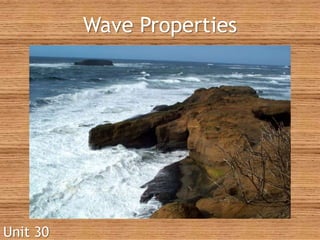Unit 30 Wave Properties
•Descargar como PPTX, PDF•
1 recomendación•2,765 vistas
Denunciar
Compartir
Denunciar
Compartir

Recomendados
Más contenido relacionado
La actualidad más candente
La actualidad más candente (20)
Waves (Grade 7, Quarter 3) Suggested Guide for Discussion

Waves (Grade 7, Quarter 3) Suggested Guide for Discussion
Similar a Unit 30 Wave Properties
Similar a Unit 30 Wave Properties (20)
Más de Olympus High School - Jeff Taylor
Más de Olympus High School - Jeff Taylor (20)
SDS Episode2 - The Habitat Requirements of Pacific Northwest Bats

SDS Episode2 - The Habitat Requirements of Pacific Northwest Bats
Unit 18a DNA fingerprinting and genetic engineering

Unit 18a DNA fingerprinting and genetic engineering
Unit 16a Resource consumption pollution and greenhouse effect

Unit 16a Resource consumption pollution and greenhouse effect
Unit 15a Habitat niche interactions and growth patterns

Unit 15a Habitat niche interactions and growth patterns
Unit 14a Relationships, biotic, and abiotic factors

Unit 14a Relationships, biotic, and abiotic factors
Último
Mehran University Newsletter is a Quarterly Publication from Public Relations OfficeMehran University Newsletter Vol-X, Issue-I, 2024

Mehran University Newsletter Vol-X, Issue-I, 2024Mehran University of Engineering & Technology, Jamshoro
Último (20)
General Principles of Intellectual Property: Concepts of Intellectual Proper...

General Principles of Intellectual Property: Concepts of Intellectual Proper...
On National Teacher Day, meet the 2024-25 Kenan Fellows

On National Teacher Day, meet the 2024-25 Kenan Fellows
Unit-V; Pricing (Pharma Marketing Management).pptx

Unit-V; Pricing (Pharma Marketing Management).pptx
Beyond_Borders_Understanding_Anime_and_Manga_Fandom_A_Comprehensive_Audience_...

Beyond_Borders_Understanding_Anime_and_Manga_Fandom_A_Comprehensive_Audience_...
This PowerPoint helps students to consider the concept of infinity.

This PowerPoint helps students to consider the concept of infinity.
Basic Civil Engineering first year Notes- Chapter 4 Building.pptx

Basic Civil Engineering first year Notes- Chapter 4 Building.pptx
ICT Role in 21st Century Education & its Challenges.pptx

ICT Role in 21st Century Education & its Challenges.pptx
Unit 3 Emotional Intelligence and Spiritual Intelligence.pdf

Unit 3 Emotional Intelligence and Spiritual Intelligence.pdf
Interdisciplinary_Insights_Data_Collection_Methods.pptx

Interdisciplinary_Insights_Data_Collection_Methods.pptx
Python Notes for mca i year students osmania university.docx

Python Notes for mca i year students osmania university.docx
Unit 30 Wave Properties
- 1. Wave Properties Unit 30
- 2. Mechanical Waves Waves are a disturbance that transfers energy from one molecule to another across space. A medium is the matter that waves travel through. It can be water, air, or even solids.
- 3. Types of Mechanical Waves There are three types of mechanical waves: Surface Waves Longitudinal Waves Transverse Waves
- 4. Types of Waves Surface Waves Surface waves travel along the surface of two separating mediums. Particles at the surface of a surface wave will rotate in a clockwise manner. See the blue particle below.
- 5. Types of Waves Surface Waves If you are swimming in the ocean and a large wave comes by, it does not push you forward, you simply rise up and down as it passes!
- 6. Types of Waves Con’t Longitudinal Waves Waves that move in the same direction as the disturbance in the medium 2 main parts Compression Rarefaction
- 7. Tsunamis Tsunamis show the effects of longitudinal waves when they retract and then advance. Often a tsunami is preceeded by a retraction of the water before the wall arrives Now the crest arrives, sending a wall of water onto the shore. Here you can see the water drawback (trough) exposing these rocks, with the incoming tsunami in the distance
- 8. Types of Waves con’t Transverse Waves Any wave in which the medium moves at right angles to the direction of the wave. 2 main parts Crest (the highest point of the wave) Trough (the lowest point of the wave)
- 10. Frequency Frequency The number of waves that pass a point in a given amount of time. Hertz The unit used to measure the frequency. 1 Hz = 1 cycle/sec Frequency is the reciprocal of the period. Freq. = 1 / Period
- 11. Period Period The period of a wave represents the time it takes one wave to pass. The period is the opposite of the frequency. Period = 1 / Freq.
- 12. Wavelength Wavelength Wavelength is measured from two identical points on wave. Usually measured from crest to crest or trough to trough
- 13. Wave Speed Speed How fast or slow the wave is moving. Formula: Speed = Frequency x Wavelength *If the speed of a wave is held constant, then as the frequency goes up, the wavelength goes down.
- 14. Wave Speed Continued Wave speed is affected by the medium Waves can travel 770 mph in air (Speed of Sound) But, 2-4 miles per second in solids (10000 mph speed of earthquake)
- 15. Earthquakes An earthquake is very similar to sound waves or waves in water. It is a disturbance in the Earth that causes a wave to travel through the solids. They are known as seismic waves.
- 16. Amplitude Amplitude The vertical distance between the line of origin and the crest or trough. The more energy a wave has then the greater the amplitude (think of an amplifier in a stereo).
- 17. Wave Behavior
- 18. Reflection Reflection When a wave bounces off of a surface. The angle the wave comes in at is equal to the angle the wave goes out at.
- 19. Refraction Refraction The bending of light as a result of a change in speed. The wave will slow down when going from a less dense medium to a more dense medium.
- 20. Interference Interference Constructive Produces one larger wave Destructive Produces a smaller wave or no wave at all. The green wave in the diagram above and to the left has combined the read and blue waves.
- 21. Diffraction Diffraction is the bending of a wave as it passes through an opening or around an object.
